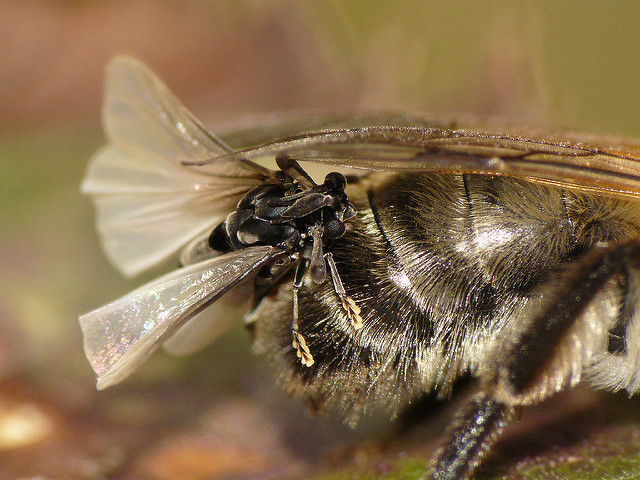The image above shows a parasitoid in action. It's a female wasp who has contorted her abdomen so that it is pointing forward. At the end of her abdomen is her egg laying tube - an ovipositor - which she will use to inject a single egg into the aphid that stands before her. Such parasitoids are available to purchase online from companies such as Koppert, Inc. Do not be alarmed, these wasps do not have stings and only lay eggs in aphids and otherwise feed on nectar and pollen. To learn more about these aphid parasitoids click here.
|
If it wasn't for parasitoids, our world would be hip-deep in bugs and worms of all kinds. Big statement. But it's true. There are ten's of thousand's of species of parasitoids described by scientists, there's probably that many more yet to be discovered and described. Their numbers are legion and they occur on every bush, tree, shrub, grass and forb in the landscape. But you don't see them because they are so very small; some are the smallest insects known. It's the female wasps that are the hunters, tirelessly searching for prey - mainly insects that eat plants. And into those insects, they inject their eggs. The hunted has now become a host that will serve as the incubator, and sole food source, for the wasp's offspring. You see it's the wasp larvae that actually do the killing by feeding on their host.
|
There are basically three types of natural enemies: Predators, parasitoids and pathogens. This page focuses on parasitoids.
Above is an Encarsia formosa parasitoid wasp. This female is injecting one of her eggs into the body of a whitefly nymph that is feeding on a plant leaf.
|
|
So, what's up with the name "parasitoid"? Is that the same thing as a parasite or not? It's something to note, but not get hung up on. A lot of people refer to these insects as parasites, but they are more properly parasitoids. That's because there are some important biological differences between them. The classical parasite that most people think of, like a tapeworm or Malaria, are typically much smaller than their host; some microscopically small. The host is usually a very different taxon, like a vertebrate host infected by a worm. Classical parasites also tend to feed on and weaken, but not necessarily kill, their hosts. Insect parasites, or parasitoids, are around the same size as their host, taxonomically closely related (both insects), and they definitely kill the host.
|
And not all parasitoids are wasps, below left is a tachinid fly that parasitizes other insects and below right is a crazy group called Strepsiptera.
|
Click on the link to this page for a gallery of amazing images of other parastioids.



